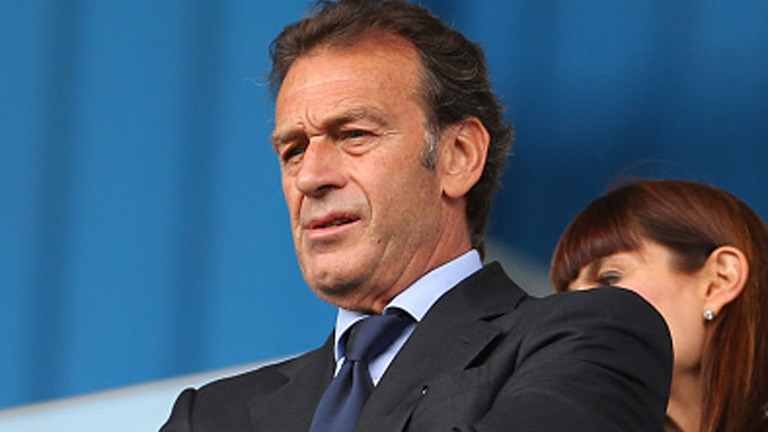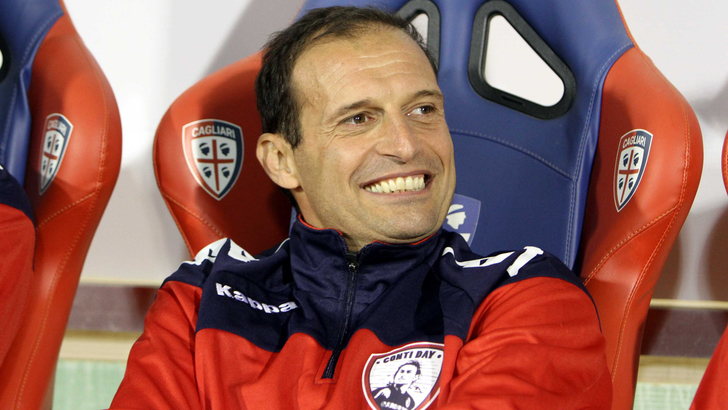Massimiliano Allegri has arguably been Italy’s most successful coach of the last decade. During this time, he has compiled an enviable CV, winning the Scudetto at AC Milan in 2011, four consecutive league and cup doubles at Juventus, as well as steering the Bianconeri to two Champions League finals. The Tuscan coach’s record at these clubs have deservedly won him plaudits at home and abroad. But his recent success owes much to his first coaching job in Serie A 10 years ago.
Back in the spring of 2008, Allegri first made waves as head coach of Sassuolo, clinching promotion to Serie B for the very first time in the club’s history. Such an achievement garnered the attention of Massimo Cellino – owner and president of Serie A side Cagliari. He was on the lookout for a new Mister after Davide Ballardini’s contract wasn’t renewed at the end of the 2007/08 season. It had been a traumatic campaign for the Rossoblu, working their way through three coaches and narrowly avoiding relegation. Allegri’s efforts at Sassuolo impressed Cellino and the capricious President appointed the 40-year-old on a 12-month contract.
Arriving in Sardinia in June 2008, Allegri faced the tough task of improving a club that had barely managed to preserve their Serie A status. One area that needed addressing was the defence, which was one of the worst in the league.
The first two signings of the Allegri era, goalkeeper Federico Marchetti and centre back Davide Astori, dealt with this weakness. Marchetti had made a name for himself with AlbinoLeffe and was regarded as the best goalkeeper in Serie B during the 2007/08 season having helped Leffe reach the promotion play-offs. As for Davide Astori, the 21-year-old was bought via a co-ownership deal with AC Milan, with Cagliari paying €1 million. The young centre-back was highly regarded and thought of as a potential successor to the Sardi’s long serving defender Diego Lopez. Meanwhile, Andrea Lazzari was signed from Atalanta to reinforce a solid midfield of Daniele Conti, Andrea Parola, Michele Fini and Davide Biondini.
If defence was a problem Allegri sought to fix, there were no such concerns in attack. Cagliari had a plethora of forwards, including Jeda, Alessandro Matri, Joaquín Larrivey and Robert Acquafresca, the latter for whom there were high expectations after he finished the previous season top-scorer with 10 goals. Thus, with new signings and a promising young coach at the helm, Cagliari’s fans hoped the new season would show marked improvement.
However, Allegri had the worst possible start to his Cagliari career, losing his first five league games. Such a dismal run of form at the start of a tactician’s tenure can often lead to an early dismissal. Moreover, the patience of Massimo Cellino was known to be infamously short. Before Allegri, Cagliari had been through 19 coaches since Cellino became owner in 1992. His nickname, The Manager Eater, was well earned.
Surprisingly, however, Cellino did not sack Allegri, but instead gave him a two-year contract extension which was signed on October 3rd but wasn’t made official until December. This backing from a trigger-happy owner allowed Allegri breathing space and gave him the confidence to make a few tweaks to his side.
Allegri’s favoured formation was a 4-3-1-2, with Andrea Cossu given the role of playmaker, tasked with supplying the strikers Jena and Joaquin Larrivey. Both strikers featured in the first five games, but only Larrivey found the net, in a 4-1 opening day loss at home to Lazio. Yet the architect of Cagliari’s first league win, two games after Allegri extended his contract, wasn’t Jena or Larrivey. It was Robert Acquafresca.
Against Torino in mid-October, Acquafresca replaced the ineffective Larrivey on 60 minutes. With five minutes of the game remaining, the young striker made an impact, coolly slotting the ball past Torino keeper Matteo Sereni after being played in by Michele Fini.
From then on, Allegri’s preference was to play Acquafresca upfront with Jena and use Matri off the bench as an impact substitute. The Rossoblu’s first league win brought confidence to the squad, as Allegri sought to lead his team up the table. After beating Torino, Cagliari put together a fine run of form, losing just three times in 10 games, winning five and drawing twice. Allegri notched up some impressive victories that made the rest of Serie A take notice. They thrashed Bologna 5-2 at home in early November and edged past Fiorentina (1-0) a few weeks later. By the winter break, Cagliari were in 13th place, a world away from September, when they were rooted at the bottom of the table.

The superstitious mind of Massimo Cellino
In the second half of the season, Cagliari continued their enterprising attack at home and began to transfer some of these performances into their away form. Lazio were taken apart 4-1 at the Stadio Olimpico, with Jena operating behind Matri and Acquafresca, which was implemented to devastating effect. All three players scored, with Jena bagging a brace. Allegri’s Cagliari also pulled off a stunning comeback away at Juventus, beating the Turin giants 3-2 having recovered from 2-1 down. The Sardi’s free-scoring football owed much to Allegri’s ability to utilise every aspect of his attack. It was Matri, for example, who scored the winner to beat Juventus on 78 minutes, just 17 minutes after coming on as a substitute.
Victory against the Bianconeri saw Cagliari climb further up the table, rising to seventh place. Hopes of qualifying for the Europa League excited the fans and local press. However, their form at the latter stage of the season was inconsistent, which meant European football in Sardinia remained a dream. It didn’t help that Cagliari would appear to save their best for the big clubs. After holding Roma to a 2-2 draw, they lost 2-1 away to relegated Reggina. This was followed up by a sensational 2-1 victory against Jose Mourinho’s Inter in their penultimate game of the season, securing the Rossoblu a ninth-place finish. In typical fashion, however, they contrived to lose their final league game away at Udinese 6-2.
Nevertheless, Allegri had worked wonders, turning a relegation-threatened side into a team pushing for European football in the space of six months. As a result, he won the Panchina d’Oro (an award for Serie A coach of the year) ahead of Jose Mourinho. Though Inter had won the league, Allegri’s accolade was well deserved. Cagliari’s ninth place finish was their highest league position for 15 years. In addition, tactical changes had helped Allegri transform a misfiring attack in September to a lethal one in May. Acquafresca (14), Jena (10) and Matri (6) accounted for over 60% of Cagliari’s league goals that season.
Furthermore, creativity from midfield helped solidify Cagliari’s forward-thinking approach. Andrea Cossu’s playmaking supplied the forwards with multiple opportunities. Cossu’s 12 assists was the joint-second highest (with AC Milan’s Kaka) in the league, behind Sampdoria’s Antonio Cassano. Michele Rini made significant contributions in his role as a regista, notching up 11 assists, while Biondini and Lazzarri helped control the midfield and provide the platform to attack.
The Sardi’s defence also improved, as Cagliari let in six fewer goals than the previous season. The catalyst for this improvement was Federico Marchetti. The goalkeeper had an outstanding debut season, keeping 12 clean sheets – joint third highest in Serie A. Marchetti only missed three league games, one of which was Cagliari’s 6-2 thrashing at Udinese. Such were his captivating performances, Marchetti was heralded the heir to Gianluigi Buffon, even garnering praise from the Juventus keeper himself.
Allegri had elevated his players to new levels, several of whom received call ups to the Italian national team. Marchetti, Cossu and Biondini were all rewarded for their excellent form during 2009.
Cagliari’s success also attracted interest in their best players. Acquafresca was called back to Inter in June and was sold to Genoa as part of Diego Milito’s move to the San Siro. 35-year-old Michele Fini also left the Rossoblu to Siena. Despite these losses, Allegri simply adapted to the situation. He bought striker Nene from Portuguese side Nacional for €4.5m and made Davide Astori his starting centre back after David Lopez’s retirement.
Cagliari couldn’t repeat their heroics of the previous season, but still hovered in mid-table throughout the 2009/10 season. Nene contributed with eight league goals while Astori missed just four league games, cementing his place as one of Italy’s most promising youngsters. In addition, the Tuscan tactician bolstered his ageing midfield in the January transfer window, signing Radja Nainggolan from Piacenza in Serie B. Before long, the Italian media were linking the Belgian midfielder to the likes of Juventus.
Unfortunately, however, Cellino eventually lived up to his Manager Eater nickname, as he relieved Allegri of his duties in April 2010. Cagliari may have won just two points from their last eight league games, but they were never in any immediate danger of being relegated. The Rossoblu’s loss would be Allegri’s gain, as he was appointed AC Milan’s new head coach in late June.
It would be the start of something special for Allegri. Indeed, his inexorable rise owes much to his formative experiences at Cagliari, which not only showcased his tactical aptitude, but also his ability to work under one of the most volatile Presidents in European football. Since then, the Tuscan tactician has never looked back. And just as he did at Cagliari, he continues to defy his detractors at Juventus.
Words by Yousef Teclab: @yousef_teclab

